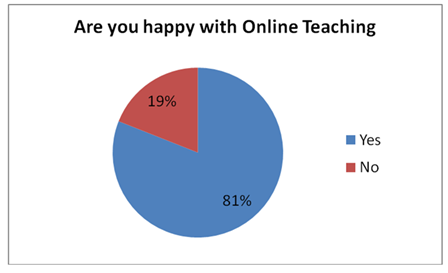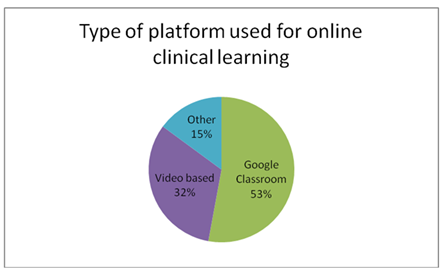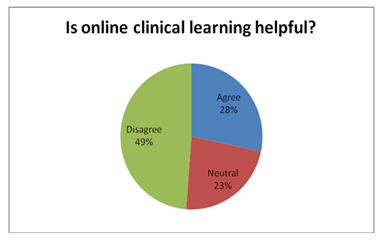Online Clinical Learning Boon or Bane? Undergraduate Students’ Perspective
Article Information
Pramila Menon1*, Vineeta Pande2, Sudhir Jadhav3, Sharad Agarkhedkar4
1Assistant Professor, Paediatrics, Dr. D Y Patil Medical College, Hospital and Research Centre, Dr. D Y Patil Vidyapeeth, Pune, Maharashtra, India
2Professor-Pediatrics, Dr. D Y Patil Medical College, Hospital and Research Centre, Dr. D Y Patil Vidyapeeth, Pune, Maharashtra, India
3Professor-Community Medicine, Dr. D Y Patil Medical College, Hospital and Research Centre, Dr. D Y Patil Vidyapeeth, Pune, Maharashtra, India
4Professor and Head-Pediatrics, Dr. D Y Patil Medical College, Hospital and Research Centre, Dr. D Y Patil Vidyapeeth, Pune, Maharashtra, India
*Corresponding Author: Dr. Pramila Menon, Assistant Professor, Paediatrics, Dr. D Y Patil Medical College, Hospital and Research Centre, Dr. D Y Patil Vidyapeeth, Pune, Maharashtra, India
Received: 21 November 2021; Accepted: 29 November 2021; Published: 28 January 2022
Citation:
Pramila Menon, Vineeta Pande, Sudhir Jadhav, Sharad Agarkhedkar. Online Clinical Learning Boon or Bane? Undergraduate Students’ Perspective. Journal of Psychiatry and Psychiatric Disorders 6 (2022): 018-024.
View / Download Pdf Share at FacebookAbstract
Introduction: E-learning is use of electronic tech-nology as a teaching-learning method to foster self-directed and collaborative learning.
Materials and methods: The study was planned through Google forms with semi structured quest-ionnaire to understand usefulness of platform for clinical skills, challenges faced and suggestions for improvement. Data was recorded on a Google excel sheet and analyzed using SPSS version 26.
Results: The sessions were attended by 166 students out of 250 on Google classroom and video sessions. The response rate was 71.4%% (95 CI 67.5-75.8), 81% (95 CI 67.5-75.8) were happy with online teaching-learning in respect to lectures, 52.9% (95 CI;47.3-58.6) are using Google Classroom, 32.2% (95 CI;27-37.6) video based platforms, 53.6% (95 CI; 48-59.2) viewed Google Classroom as the best platform while 44.1% (95 CI;38.5-49.7) favoured video based platforms. Students felt online teaching is suitable for classes which are theoretical in nature, but they are not very useful for practical clinical training. They liked flexibility and ownership of resource material. E- learning was perceived by 64% students as not fruitful, 48.8% students not helpful them to learn clinical skills and 52.5% students reacted it is not boon but creating anxiety in their mind. Some expressed their feelings as online clinical training is useless (64%).
Conclusion: We conclude that online teaching is possible and acceptable as a complementary method to the traditional or conventional method of medical teaching in India as a normal part of the curriculum, irrespective of the lockdown period. The blended learning mode will be the best solution.
Keywords
Clinical learning; E-learning; Electronic technology; Collaborative learning
Clinical learning articles; E-learning articles; Electronic technology articles; Collaborative learning articles
Clinical learning articles Clinical learning Research articles Clinical learning review articles Clinical learning PubMed articles Clinical learning PubMed Central articles Clinical learning 2023 articles Clinical learning 2024 articles Clinical learning Scopus articles Clinical learning impact factor journals Clinical learning Scopus journals Clinical learning PubMed journals Clinical learning medical journals Clinical learning free journals Clinical learning best journals Clinical learning top journals Clinical learning free medical journals Clinical learning famous journals Clinical learning Google Scholar indexed journals E-learning articles E-learning Research articles E-learning review articles E-learning PubMed articles E-learning PubMed Central articles E-learning 2023 articles E-learning 2024 articles E-learning Scopus articles E-learning impact factor journals E-learning Scopus journals E-learning PubMed journals E-learning medical journals E-learning free journals E-learning best journals E-learning top journals E-learning free medical journals E-learning famous journals E-learning Google Scholar indexed journals Electronic technology articles Electronic technology Research articles Electronic technology review articles Electronic technology PubMed articles Electronic technology PubMed Central articles Electronic technology 2023 articles Electronic technology 2024 articles Electronic technology Scopus articles Electronic technology impact factor journals Electronic technology Scopus journals Electronic technology PubMed journals Electronic technology medical journals Electronic technology free journals Electronic technology best journals Electronic technology top journals Electronic technology free medical journals Electronic technology famous journals Electronic technology Google Scholar indexed journals Collaborative learning articles Collaborative learning Research articles Collaborative learning review articles Collaborative learning PubMed articles Collaborative learning PubMed Central articles Collaborative learning 2023 articles Collaborative learning 2024 articles Collaborative learning Scopus articles Collaborative learning impact factor journals Collaborative learning Scopus journals Collaborative learning PubMed journals Collaborative learning medical journals Collaborative learning free journals Collaborative learning best journals Collaborative learning top journals Collaborative learning free medical journals Collaborative learning famous journals Collaborative learning Google Scholar indexed journals paediatrics articles paediatrics Research articles paediatrics review articles paediatrics PubMed articles paediatrics PubMed Central articles paediatrics 2023 articles paediatrics 2024 articles paediatrics Scopus articles paediatrics impact factor journals paediatrics Scopus journals paediatrics PubMed journals paediatrics medical journals paediatrics free journals paediatrics best journals paediatrics top journals paediatrics free medical journals paediatrics famous journals paediatrics Google Scholar indexed journals Online e-learning articles Online e-learning Research articles Online e-learning review articles Online e-learning PubMed articles Online e-learning PubMed Central articles Online e-learning 2023 articles Online e-learning 2024 articles Online e-learning Scopus articles Online e-learning impact factor journals Online e-learning Scopus journals Online e-learning PubMed journals Online e-learning medical journals Online e-learning free journals Online e-learning best journals Online e-learning top journals Online e-learning free medical journals Online e-learning famous journals Online e-learning Google Scholar indexed journals Cultural resistance articles Cultural resistance Research articles Cultural resistance review articles Cultural resistance PubMed articles Cultural resistance PubMed Central articles Cultural resistance 2023 articles Cultural resistance 2024 articles Cultural resistance Scopus articles Cultural resistance impact factor journals Cultural resistance Scopus journals Cultural resistance PubMed journals Cultural resistance medical journals Cultural resistance free journals Cultural resistance best journals Cultural resistance top journals Cultural resistance free medical journals Cultural resistance famous journals Cultural resistance Google Scholar indexed journals mean score articles mean score Research articles mean score review articles mean score PubMed articles mean score PubMed Central articles mean score 2023 articles mean score 2024 articles mean score Scopus articles mean score impact factor journals mean score Scopus journals mean score PubMed journals mean score medical journals mean score free journals mean score best journals mean score top journals mean score free medical journals mean score famous journals mean score Google Scholar indexed journals practical training articles practical training Research articles practical training review articles practical training PubMed articles practical training PubMed Central articles practical training 2023 articles practical training 2024 articles practical training Scopus articles practical training impact factor journals practical training Scopus journals practical training PubMed journals practical training medical journals practical training free journals practical training best journals practical training top journals practical training free medical journals practical training famous journals practical training Google Scholar indexed journals clinical skills articles clinical skills Research articles clinical skills review articles clinical skills PubMed articles clinical skills PubMed Central articles clinical skills 2023 articles clinical skills 2024 articles clinical skills Scopus articles clinical skills impact factor journals clinical skills Scopus journals clinical skills PubMed journals clinical skills medical journals clinical skills free journals clinical skills best journals clinical skills top journals clinical skills free medical journals clinical skills famous journals clinical skills Google Scholar indexed journals
Article Details
1. Introduction
E-learning can be defined as the use of electronic technology as a teaching-learning method which provides easy and effective information to students [1]. It is an effective tool to foster self-directed learning which gives the students greater control over their learning [2]. It has learner-centred approach with focus on faculty- participants interaction to develop collaborative learning which may be synchronous or asynchronous [3]. Due to the Corona virus pandemic, offline teaching came to halt. The nationwide lockdown imposed due to pandemic forced the world to shift to E learning strategy to reach out to students.
Hence, the need for online classes was felt and E-learning platforms were explored. The study was undertaken with aim to understand the acceptance and feedback of students in respect of online classes to learn clinical skills. The effort was made to understand the challenges and to find out solutions for better implementation of online classes for medical students in paediatrics.
2. Material and Methods
The study was planned at the department of paediatrics at Dr D Y Patil Medical college, Pune. The faculty and students were trained through video-based platform like Zoom (free version), Cisco Webex, Skype, Google Classroom and Google Groups. The approval for the study was obtained from the institutional ethics committee(Ref no: I.E.S.C/28/2020).
A google form was designed which included semi structured questionnaire focussing on platform used for online teaching learning, advantages, comfort level, usefulness of platform for clinical skills, challenges faced and suggestions for improvement. Data was recorded on a Google excel sheet and analyzed using SPSS version 26.

Figure 1

Figure 2
3. Results
The sessions were attended by 166 students out of 250 on Google classroom and video sessions. The response rate was 71.4%% (95 CI 67.5-75.8). As shown in Figure no.1, 81% (95 CI 67.5-75.8) participants were happy with the ongoing online teaching-learning in respect to lectures. Figure no.2 shows that 52.9% (95 CI;47.3-58.6) are using Google Classroom, 32.2% (95 CI;27-37.6) are using video based platforms like Zoom, Google Meet, Cisco Webex etc. 53.6% (95 CI; 48-59.2) participants viewed Google Classroom as the best platform while 44.1% (95 CI;38.5-49.7) favoured video based platforms for teaching-learning (Figure no.3).
Students felt online teaching is suitable for classes which are theoretical in nature, but they are not very useful for clinical training. They liked flexibility and ownership of resource material. The only advantage would be that “we can attend during a pandemic”. It's like"something is better than nothing”. The difficulties faced were network issues and connectivity. We also looked at the disadvantages of online clinical skills classes.

Figure 3
E-learning was perceived by 64% students as not fruitful. 48.8% students felt that online clinical teaching is not helping them to learn clinical skills. 52.5% students reacted it is not boon but creating anxiety in their mind as it is not making them confident to manage the patients. The students’ responses highlighted the anxiety on their part. Some expressed their feelings as that online clinical training is useless (64%).
One of the response from our student made us introspect ourselves as teachers. ”Because I know I’m not a very bright student and I don’t want to make blunders ahead. Please extend our session if you really care about us “.
4. Discussion
Medical education which included clinical skills training faced a challenge. As the exposure to real patients was not available, it was imparted through video recordings and demonstrations online. Online learning has some advantages over traditional learning in delivery of the newest evidence-based medicine. There are no geographical barriers which results in better communication and networking with health care professionals from different countries can be done.
Our students described it as learning anytime anywhere around the world. Its flexibility ensures that the learner gains more control over their learnin [4] .Our students felt access to study material anytime helped them to understand the concepts at their pace.
Some of the students’ responses in their own words.
“Considering the profession we have chosen, we need to have a clinical exposure to different patients which is not possible through inline classes. Classroom experience is totally missing. The bond of trust that forms when a doctor communicates with the patient lacks. We can't become doctors sitting at home. We don't get to actually see and ask patients. Viva will be difficult for us. Clinical training requires looking at the patients and also develops our communication skills which is important for a medical student. At least for a final year student, we should be allowed to Look and talk to patients.” To get medical knowledge and competency, patients’ contact is very much needed and they cannot only rely on books [5]. It is proved that the students may not develop necessary clinical skills through online education systems, but it may exacerbate the burden on their mental health [6]. Using online resources to simulate clinical scenarios and in depth discussion on patient care and diagnosis can get students to develop out of the textbook thinking. It is a boon in this pandemic but not helpful as such in clinical skills.
The success of online teaching/learning depends on many factors. Both students’ and teachers’ perspectives are important to make it effective [7]. “Cultural resistance” of staff towards E- learning is identified as a barrier to student engagement with technology-based education. Hence, initiatives in favour of faculty orientation and training in respect of E-learning are necessary to successfully introduce e-learning programs. Orientation and training programmes were carried out on in our college as part of our medical education activities. Our faculty found difficulties in the beginning and there was reluctance, but gradually they became familiar with this mode. However, they observed that the students were unresponsive at times and it was difficult to understand if they had any concerns. It is suitable for didactic lectures but not for clinical/practical training. WHO, UNICEF report 2017 suggested that online learning is feasible and effective for training health care professionals in acquiring knowledge and skills related to essential newborncare. Nearly 3500 physicians and over 1000 nursing professionals were trained in 12 sick newborn care courses and five essential newborn care courses [8, 9]. Stewart, et al. 2013 found that the group of medical students who received blended learning which had an online component in addition to the conventional teaching, achieved a significantly higher mean score in a module for teaching newborn physical examination skills than the control group [10]. The students wanted online classes for lectures to be continued even after the lockdown period. Similar experience shared by Scagnoli et al shows the importance of online training in COVID pandemic for pediatric undergraduate students [11]. Flexibility of E-learning provides information to the students beyond the specified timings of teaching in class and gives them freedom to read and learn whenever they feel the need for the same.
The same was documented in a Nigerian study and this point was also highlighted by our students [12]. Apart from the fruitful use of the lockdown period in the corona pandemic, the present study revealed the acceptability of the online learning mode by the students and faculty with few suggestions. To help the students to develop clinical skills we may need to adapt the blended mode. As we move on to un lockdown mode the students should be posted to clinical rotations in small groups.
5. Conclusion
Online e-learning is extremely crucial in the pandemic but should not replace the time-tested conventional classroom teaching especially in the medical field. The suggestions by the students included that e-learning should be blended with the conventional teaching and adopted as a regular part of the curriculum. We conclude that online teaching is possible and acceptable as a complementary method to the traditional or conventional method of medical teaching in India as a normal part of the curriculum, irrespective of the lockdown period. The blended learning mode will be the best solution.
References
- Mooney G, Bligh J. Information technology in medical education: current and future applications a shift in medical education practice from traditional forms of teaching to other media which employ online, distance or electronic learning
- Ruiz JG, Mintzer MJ, Leipzig RM. The impact of E-learning in medical education. Acad Med 81 (2006): 207-212
- Nimavat N, Singh S, Fichadiya N, et al. Online Medical Education in India – Different Challenges and Probable Solutions in the Age of COVID-19. Adv Med Educ Pract 12 (2021): 237-243.
- Barteit S, Guzek D, Jahn A, et al. Evaluation of e-learning for medical education in low- and middle-income countries: a systematic review. Comput Educ 145 (2020): 103726.
- Byrnes YM, Civantos AM, Go BC, et al. Effect of the COVID-19 pandemic on medical student career perceptions: a national survey study. Med Educ Online 25 (2020): 1798088.
- Costello E, Corcoran M, Barnett J, et al. Information and communication technology to facilitate learning for students in the health professions: current uses, gaps and future directions. Online Learn 18 (2014).
- Bediang G, Stoll B, Geissbuhler A, et al.Computer literacy and e-learning perception in Cameroon: the case of Yaounde Faculty of Medicine and Biomedical Sciences. BMC Med Edu 13 (2013): 1-8.
- Reaching the Every Newborn National 2020 Milestones Country Progress, Plans and Moving Forward Geneva: World Health Organization. WHO, UNICEF report 2017 (2017).
- Thukral A, Sasi A, Chawla D, et al. Online neonatal training and orientation programme in india (ontop-in)—1/nthe way forward for distance education in developing countries. J Trop Pediatr 58 (2012): 486-489.
- Stewart A, Garry I, Jardine L, et al. A randomised controlled trial of blended learning to improve the newborn examination skills of medical students. Arch Dis Child-Fetal Neonatal Ed 98 (2013): F141-F144.
- Scagnoli NI, Choo J, Tian J. Students' insights on the use of video lectures in online classes. Br J Educ Technol 50 (2019): 399-414.
- Obi IE, Charles-Okoli AN, Agunwa CC, et al. E-learning readiness from perspectives of medical students: a survey in Nigeria. Niger J Clin Pract 21 (2018): 293-300.
